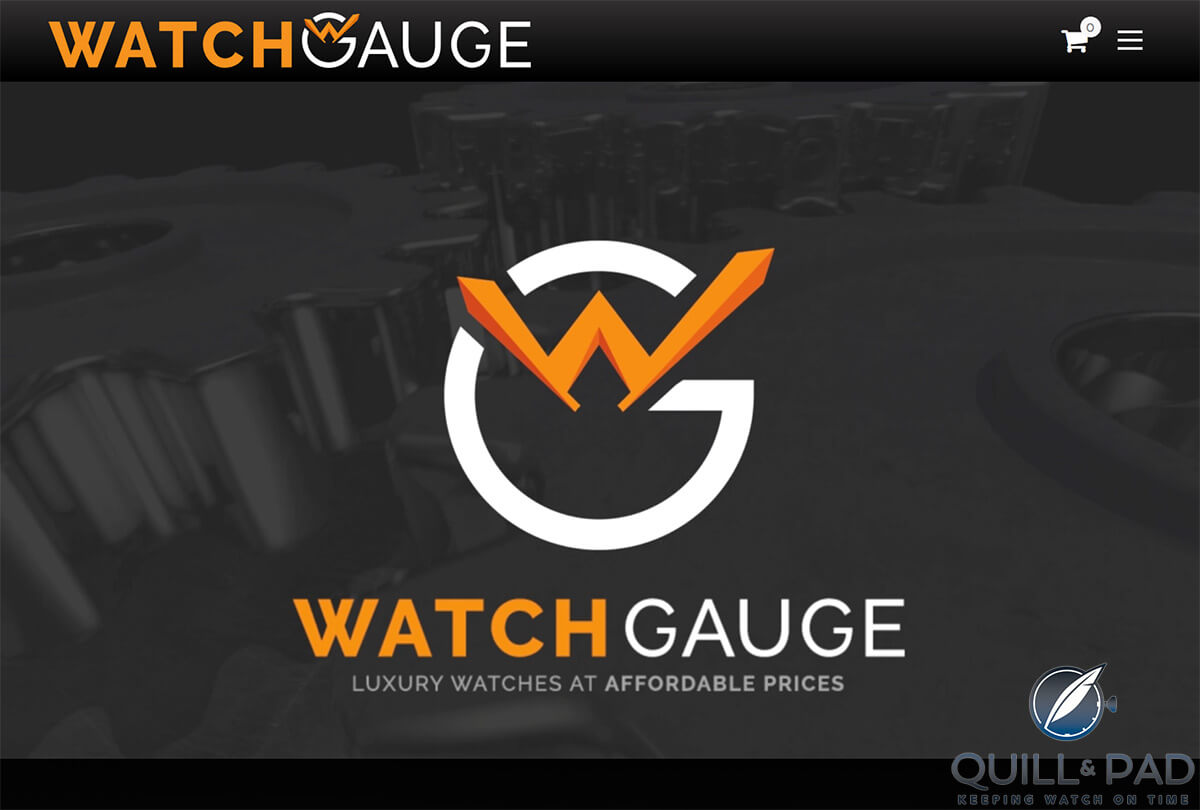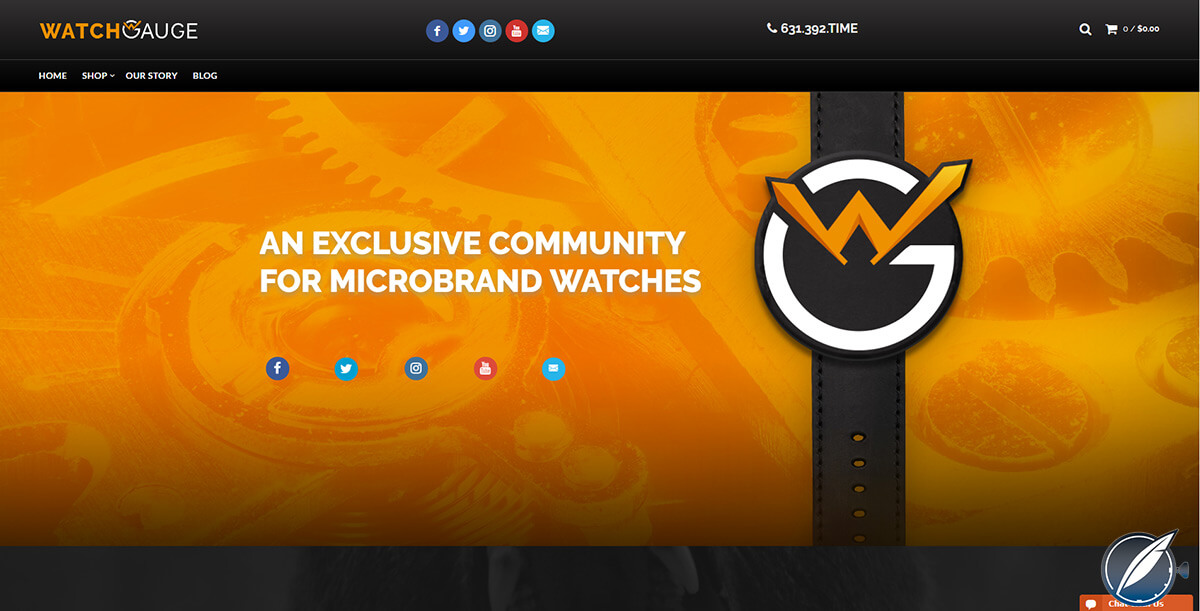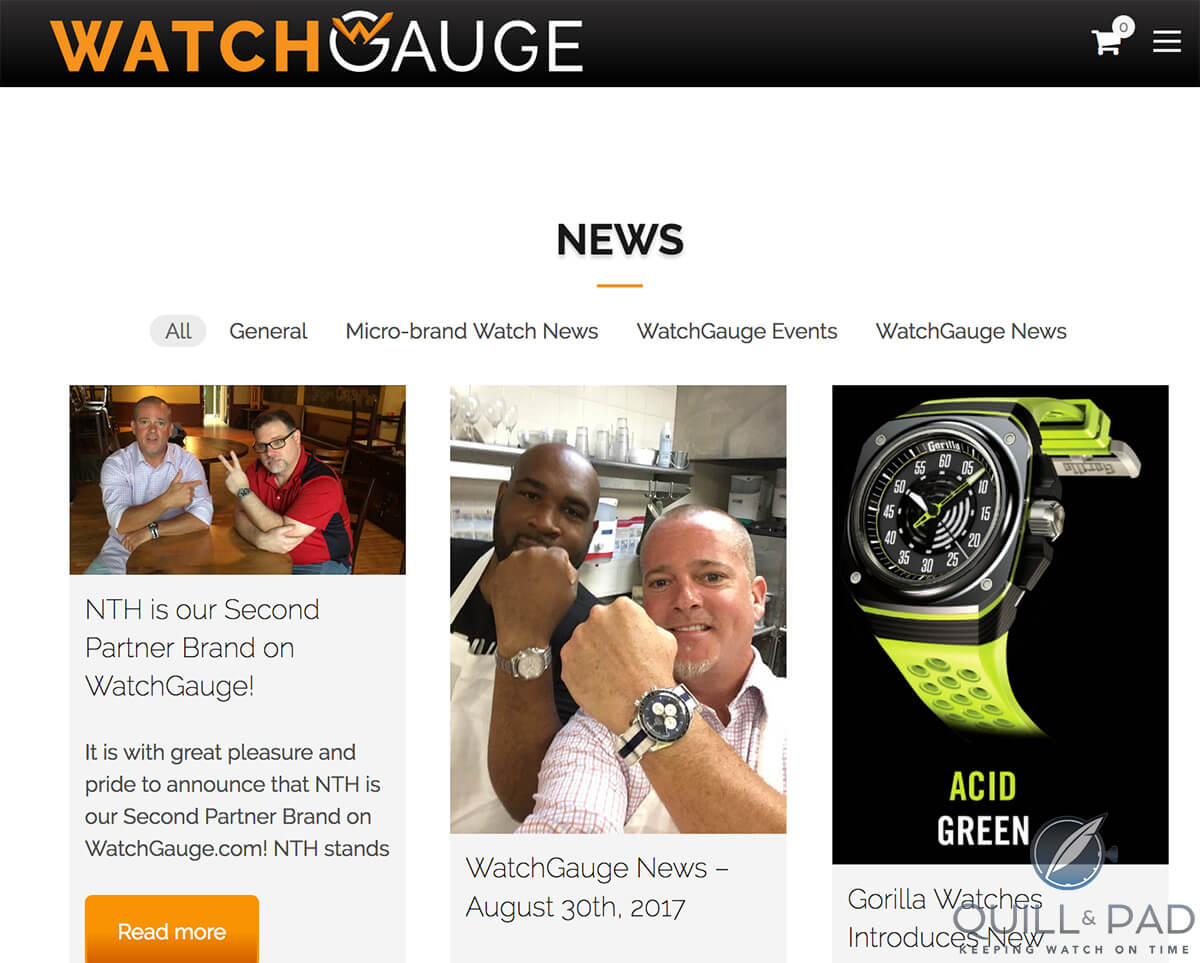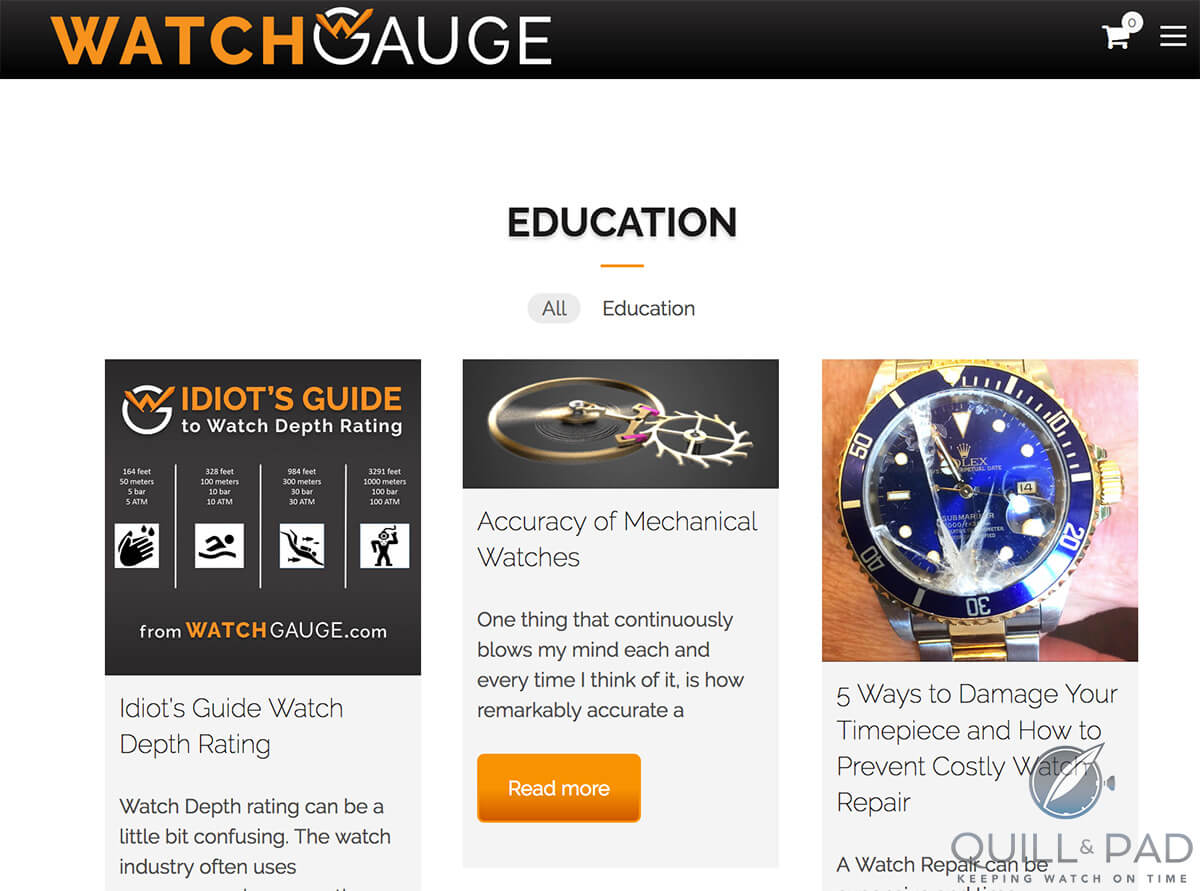Quill & Pad’s resident retail expert John Keil has just launched WatchGauge, an interesting new online retail venture that is worth bringing to your attention.
The aim of WatchGauge is to help the consumer wade through the crowded and sometimes murky waters of the emerging micro brand scene. If you’re not sure what I mean by that, imagine the following scenario.
You’re in the United States and you walk into a good party store in search of an interesting beer. You’re not a Bud man and you’ve had enough Heineken to last you a lifetime, so you’re in the mood to try something new. You like good beer, but you are not a beer connoisseur. How can you ever pick from the vast selection now available in party stores from local micro breweries, state-wide micro breweries, and national micro breweries touting pale ales, IPAs, lagers, pilsners, and even more?
The emerging micro brand scene is a lot like the modern beer scene – it is very difficult, bordering on impossible, to know every brand and every watch these days!
And here’s where WatchGauge comes in (boy, I wish there was a WatchGauge for micro breweries!), a new retail site that is also conceived to be a community for micro brand watches.

And if anyone knows how to build such a community, it’s John Keil, who with his passion for horology has created a platform to educate and entertain as well as offer the best of the best in terms of micro brands.
An 18-year veteran of the watch industry, Keil started his run as the national sales manager for Chronoswiss USA. This is where I first met him, and we naturally ran into each other regularly at events and gatherings after that.
A few years later Keil went on to manage one of the most prestigious timepiece retailers in New York, a position he remained in for close to 14 years, leaving in 2014 to start his own consulting practice for designing high-end custom timepieces for corporations and collectors.
I talked to Keil about WatchGauge to get the low-down as it is a fascinating layer of the industry to be in at a time when it is practically pioneer work. Please enjoy his candid answers and be sure to check out WatchGauge, which just launched Gorilla as its very first partner brand and NTH as its second. New partner brands are scheduled to be announced weekly for many more weeks, so keep checking back there.
ED: Please define “micro brand.”
JK: Great question because up until two years ago or so, I myself wasn’t even familiar with the term. To paint the term with a broad brush, a micro brand is typically a small, independently owned brand that manufactures on a very small scale.
I have found that most micro brands are founded by a designer or someone who loves watches with a great idea for a watch or brand. Or somebody like Ming, who as a passionate watch enthusiast knew what he wanted in a watch but just couldn’t find it in anything that was on the market [see Ming Thein’s own words and photos on this subject in Design Your Own Watch? A Collector Explains The Pros And Cons With Ochs Und Junior].
It seems that most micro brands fit into the price range of $300 up to $1,200 or so. What is interesting is that bang for the buck; I feel like a consumer can get so much more from many of the micros with regards to quality, materials, and such over big established brands.
Unlike the large established brands, micro brands don’t have a huge marketing budget and their distribution models usually don’t include a distributor (and in most cases even a retailer). So there is less of a markup, and, finally, it is what the market dictates in a way.
If someone were going to spend $800 on a watch, it either has to have a well-established brand name/history, or it has to offer more in terms of quality and design.
ED: Is product price the only difference you see between the labels “micro brand” and “independent watchmaker” or “boutique brand”?
JK: No. While the prices of the watches are certainly what stands out to most, independents and boutique brands are normally very well-funded. They have relatively large marketing budgets, teams of designers, watchmakers, and other staff.
In most cases, a micro brand has a team of one or two people. Additionally, the founders or heads of independent operations and boutique brands are well-established industry people who have strong reputations and a history of success in the industry. There are very few micro founders who can boast the same. Most are watch enthusiasts with an idea and guts!
Someone like Octavio Garcia of Gorilla Watches, previously of Audemars Piguet, is the exception.

ED: What fascinated you so much about micro brands that you decided to make your 9-5 revolve around them?
JK: 9-5? You know better, Elizabeth! Like Quill & Pad, WatchGauge is 24/7!
On a serious note, it was a few things about micro brands that got my attention and ultimately won over my enthusiasm.
As the ever information-hungry watch nerd, I visit at least 10-15 blogs or watch sites daily. Over the past few years, literally hundreds of micro brands have emerged thanks to crowdfunding sites like Kickstarter. With that comes a ton of press releases, sponsored posts, etc., so I was absorbing a lot of that stuff. I also paid attention to the comments on those blogs by the readers and I was quite surprised about all of the praise some of these brands were getting from watch collectors.
Additionally, since leaving the life of being an employee and going into the world of business ownership in 2014, I began working with corporations and wealthy individuals designing and having bespoke limited editions of high-end watches made.
Along the way, there were some cases where we were asked to look at doing more affordable watches that could be made on a somewhat larger scale of a few hundred pieces for corporate giveaways. Most of the big brands aren’t willing to put the time and resources into less than a few thousand pieces, which forced me to look at the idea of micro brands, again leading me to like them more the more I researched.
ED: How does working with micro brands differ from working with established haute horlogerie brands?
JK: Oh, it’s so different! Although most of the people who I’ve dealt with in the haute horlogerie world were wonderful and nice, at the end of the day most of the brands treat retailers like they were doing us a favor by “allowing” us to sell their watches. Some brands much worse than others.
In the micro brand world, most of those I deal with are the founders and owners. Most of them are still or not far out of the start-up phase and are very humble and excited that a retailer such as WatchGauge wants to do business with them.
There is a lot more idea sharing and desire among the micro brands to collaborate to help each other out, too. In the haute horlogerie world it’s the brands’ way or the highway. Certainly not all luxury brands are that way, but more are than not.
ED: How does working with micro brands differ from independent watchmakers or boutique brands?
JK: Conducting business with independents and boutique brands is much more similar to working with micro brands. Working with people like Max Büsser (MB&F) or Jean-Marie Schaller (Louis Moinet) is much more engaging for both the retailer and watch client as they are also much more willing and excited to get involved with limited editions, one-of-a-kinds, events, and projects.
Also, if a client sends an email or inquiry, they would likely be the people responding personally, not someone toward the lower end of their company’s totem pole. I mention these two fine men because I have first-hand experience working with them and I’d jump at the opportunity to do so again!

ED: What would you tell someone usually solely interested in high-end watches to interest them in micro brands?
JK: I have always loved watches in all price ranges. Even when I was solely in the high-end arena, I’d get just as excited about getting a new G-Shock or Shinola as I would about an Audemars Piguet. So if that someone is like me and loves watches of all calibers, I’m sure I’d create a collecting monster out of them!
Perfect example (on a different scale): in luxury retail I had a great client for years that only purchased watches in the $15,000-$20,000 range and up. When I became a Bremont retailer in 2012, a brand whose watches are in the $5,000 price range, he came in once intending to spend $20,000 plus. As we passed the Bremont case, I pointed the watches out, told their story, and shared my love for them. He ended up purchasing five of them over the next six weeks or so. He also turned a handful of his friends on to Bremont, which resulted in more pieces being purchased.
Point being that I think if someone truly loves watches and isn’t concerned about impressing others by the price/name brand of a watch, it’s hard not to love what some of these micro brands are creating!
ED: Give us an idea of the kind of quality for money to expect?
JK: That can be the tricky part with micro brands and part of the reason I think a site like WatchGauge is so needed right now. Many, if not most, of the components are manufactured in China – like the cases, bracelets, dials, etc. As in any manufacturing in any country, the quality will vary greatly from manufacturer to manufacturer. Many of the micro brand owners go through a ton of trial and error with different components and unfortunately with their already slim budgets, it’s a scary and costly business exercise.
That said, there are some really great manufacturers in China as well who turn out great product, and this can be clearly seen in the brands that WatchGauge has partnered with.
One thing I’ve learned and have grown to admire is the relationships among micro brand owners. During various conversations I’ve had with Chris Vail (Janis Trading, NTH, and Lew & Huey), he has discussed how he and other brand owners share tons of manufacturing information with each other: which manufactures make which components well, which ones to avoid, and so on. Micro brand owners are a tight community in and of themselves and seem to look out for one another.
And, let’s be honest, most of the well-established, big Swiss brands have most of the same types of components made in China as well. It’s just not as openly discussed.
At WatchGauge, we research all of the micro brands and choose to partner with only the ones whose quality is far above what you’d normally see in a sub-$1,000 watch.
ED: Give us an idea of the kind of design and originality to expect?
JK: This is where I get excited. I think a large portion of the micro brands coming out are “meh” – copies of something that came before them. The other small percentage, however, is in my opinion awesome! We choose our partner brands for the reason that they really offer something unique, well made, and exciting. Take the Gorilla Fastback, for instance.
It is constructed in ceramic, anodized aluminum, forged carbon, and titanium! Add sapphire crystal and an automatic movement for $880. And it doesn’t look like anything else I’ve ever seen on the market. I know it’s apples and oranges, but Audemars Piguet’s Forged Carbon Offshore is in the $30,000 range and Hublot’s Forged Carbon Big Bang is, what, $15,000-20,000?
Before filtering through all of the brands for quality as I had mentioned, first and foremost a micro brand has to catch my eye: the micro brands who have any bit of success can likely attribute that to unique and desirable designs. Some brands take cues from watches like the Rolex Submariner or Omega Seamaster, or other iconic watches, but they also have some other characteristics that make them original. Let’s face it; making a blatant knockoff isn’t a good recipe for long-term success.
Again, this is why I feel a site like WatchGauge is such a good idea. Watch enthusiasts have to spend a ton of time researching and digging to see what’s original and well made. Curating a great group of brands will be a huge benefit to them.
ED: Where do micro brands generally manufacture their watches?
JK: A lot of components as I mentioned are made in China. I’d say that the majority use movements from Japan from companies like Seiko and Miyota. Like ETA, those brands’ movements are tried and tested to be very reliable. Some brands use movements made in China from Seagull or others, but not any that we’ve partnered with that I’m aware of.
Another thing I really wanted to mention here is the transparency in the micro community. Most micro brands are happy to discuss the origins of their components, and in a few cases they even wear it as a badge of honor! Take Code 41, for instance: this brand has a “Total Transparency of Origin” right on its site stating where everything is sourced.
Imagine the big Swiss brands doing the same?!?
ED: Where are micro brands usually headquartered?
JK: That’s another thing that I’m loving about launching WatchGauge! The brands themselves are based all over the world. Many here in the U.S., but I am also thrilled to be fostering relationships with brand owners in the Netherlands, UK, Switzerland, Germany, Australia, New Zealand, Indonesia, and others.

ED: In the fast-paced world of micro brands, how does the community you plan to build play a role?
JK: We have a lot of ideas we’re going to implement that are unique to the industry, but one of the keys to our plan is supporting the micro community as a whole, not just the brands we will sell.
About two years ago, even prior to my deeper interest in micro brands, I became friends with Marvin Menke, founder of Hemel Watches. He and I have discussed collaborating on media to help each other out and cross pollinate our fans. The funny thing is that I won’t be selling his watches – and not because they aren’t awesome; they are! – but because he sells through another good friend, and we have a gentleman’s agreement not to step on each other’s toes.
With how accessible and engaging the micro brand owners are, we hope that they’ll get involved with our content as well. I’m planning on doing interviews, participating in events, watch reviews, and anything else we can to be that conduit between micro brands and consumers.
ED: Do you ship outside the U.S.?
JK: Initially I think we will only ship to the U.S., Canada, and the UK. No offense at all intended to the rest of the planet, but in all honesty, I am very new to selling online. I have been advised by many who have a lot of experience who have suggested that I take it slow with learning the ins and outs of international shipping and that it is easier to be protected from any sort of elaborate scams if I stick with these three countries for a while.
This isn’t to say that I wouldn’t be willing to entertain the idea, but I want to protect our investment in WatchGauge.
ED: Tell me about your customer service and return policy.
JK: Returns will be seven days, no questions asked as long as the watch is returned “as sent” with plastics and stickers still intact from the manufacturer and nothing is damaged. Of course, there are circumstances where we may have to be more lenient. The beauty of running such a small operation is that I’m really the only one in contact with our clients and I’m very easily reached: we’ve even got my direct phone number right on the top of our home page.
On a side note, it drives me crazy when the only way to contact a company is through a form on its contact page. What if the client has a more pressing issue aside from a simple inquiry?
With regard to service there are a few different ways to handle service issues that we’ve put in place. Obviously, if it is a manufacturer’s defect issue, the brands themselves all have their own warranties and service policies in place. WatchGauge will take care of expediting and staying on top of the process and will be responsible for making sure everything is handled properly and in a timely fashion.
If it is not a defect issue or something else, I have a great watchmaker I’ve worked with in the past who is CW21 certified and more than qualified. In the beginning, as repairs come in I’ll bring them to his shop. As we get larger and busier, I’ll set him up with space in the WatchGauge office to come and work here. It’ll be an investment in equipment and such, but certainly well worth it.
For more information, please visit www.watchgauge.com.





















































Trackbacks & Pingbacks
[…] * This article was first published on September 7, 2017 at Haute Horlogerie Enthusiast John Keil Goes Micro Brand And Launches WatchGauge, A Novel Community An…. […]
[…] There is no doubt that Kickstarter has become one of the most important platforms for introducing interesting new watch brands and watches – and especially in the fascinating new arena of micro brands, Kickstarter has become indispensable. One new micro brand that has been quite successful on Kickstarter is Pramzius, whose debut watch you can read about in Put The Trans-Siberian Railroad On Your Wrist With A Pramzius Watch. (For more on micro brands and the new role they play in the watch world, see Haute Horlogerie Enthusiast John Keil Goes Micro Brand And Launches WatchGauge, A Novel Community An….) […]
[…] rise of micro brands over the last few years has given watch lovers everywhere a chance to be a part of something new, […]
[…] So without further ado, click here to see what she wrote. I am quite thankful and proud. […]
Leave a Reply
Want to join the discussion?Feel free to contribute!